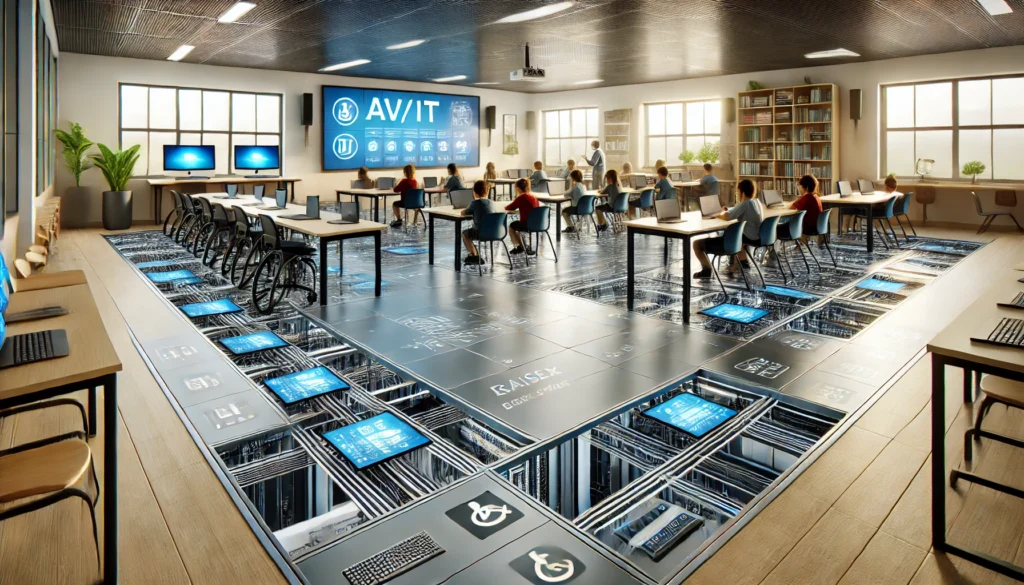While many businesses were able to shift to remote working options during the pandemic, many schools and colleges lack the needed data infrastructure to support the 73 million students across the US. The mass migration to remote learning involves more than access to the school portal. Educators and administrators also had to deal with access control, data security, and the bandwidth required to support legacy and newer AI technologies to instruct and test students.
Due to the shortcomings exposed by the pandemic, the Office of Educational Technology1recently released five new technology infrastructure guidelines for primary and secondary public schools, colleges, and universities.
Table of Contents
1. Digital infrastructure should be adequate and future-proof. Connections, speeds, and devices should be designed to meet the needs of modern education with plans for financial sustainability. This infrastructure should also be scalable to meet future needs.
2. Digital infrastructure should be defensible and resilient. Cybersecurity risk presents both a management and technical challenge. Ensuring the safety of people, data, and systems requires continuously building capacity to mitigate and respond to current risks like ransomware, as well as evolving cyber threats.
3. Digital infrastructure should be privacy-enhancing, interoperable, and useful. By prioritizing privacy and ensuring data protection measures, schools build trust with stakeholders and maintain the confidentiality and integrity of sensitive student data. Embracing interoperability standards can enable the seamless exchange of data between systems, empowering educators to make informed decisions and personalize learning experiences.
4. Digital infrastructure should be accessible to individuals with disabilities and multilingual learners. Schools must provide equal access to individuals with disabilities. Planning for accessibility at all stages of the technology life cycle – procurement, implementation, training, and support – as well as ensuring alignment to key accessibility-related frameworks and guidelines helps ensure that a school’s digital infrastructure is readily accessible to individuals with disabilities.
5. Digital infrastructure should enhance student digital health, safety, and citizenship skills. Digital infrastructure should be designed to protect and improve the digital health, safety, and citizenship skills of the people within that system, including the privacy of their data.
The Office of Educational Technology recommends designing classrooms with an adaptable and flexible AV/IT infrastructure, such as a raised access flooring system. This option allows campuses to quickly make changes necessary to meet different data needs and class sizes while keeping pace with new technologies and their implementation.
The Role of Access Flooring in the Classroom
Currently, 97% of schools (public, private, colleges, and universities) use internet connectivity in the classroom. Many educators today rely on a myriad of different technologies to incorporate images, videos, and audio files into their curriculum and teaching plans. Additionally, school administrators are challenged with student safety issues, such as access controls, campus security, and upgrading bandwidth to meet the data-heavy demands of AI (Artificial Intelligence) technologies.
Unfortunately, most data cabling used in schools and commercial spaces relies on cable trays hidden above the suspended ceiling. Adding a new workstation or connectivity point requires opening the ceiling between the affected connection points to facilitate the new cable installation. Consequently, even a minor cabling change can require several contractors to complete, greatly inconveniencing students and faculty members.
By incorporating a raised access flooring system, new and existing schools can reduce future technology upgrade costs and project timelines2. For example, the Gridd Adaptive Cabling System uses modular steel panels to create a new ground-level airspace above the existing concrete floor. Once the data and power cables have been relocated, the contractor removes modular floor covering, such as a few carpet tiles or LVT (Luxury Vinyl Tile) to access the affected cabling. The floor covering is reinstalled once the work is complete, and any desks or furnishings are replaced.
Schools can further reduce future construction costs by relocating their power management system underfoot using the Gridd Power® system. Connections can be field-wired to the central panel or made via a modular branch circuit for increased flexibility and adaptability. Gridd Power provides an integrated 50-amp modular bus system that works seamlessly with the Gridd Adaptive Cabling Distribution System. Together these systems convert complicated data and power management into a plug and play network that can be quickly changed or updated.
As the number of elementary, secondary, and college students grows, existing school infrastructures must be updated to handle the classroom tech needs of today and the future. However, they must also be flexible and adaptable enough to incorporate future technologies that can improve the learning process for all students.
As more schools prepare to incorporate the newest technology requirements, educators and administrators need a flexible and adaptable cabling solution that works today and well into the future. Today’s Gridd components are 100% compatible with Gridd components manufactured over twenty years ago to provide a superior ROI while lowering future construction and maintenance costs. To learn more about cost-effective data and power cabling solutions for campuses large and small, contact a Gridd Advisor.
Resources:
1. https://tech.ed.gov/files/2023/08/FINAL_Adequate_FutureProof.pdf

